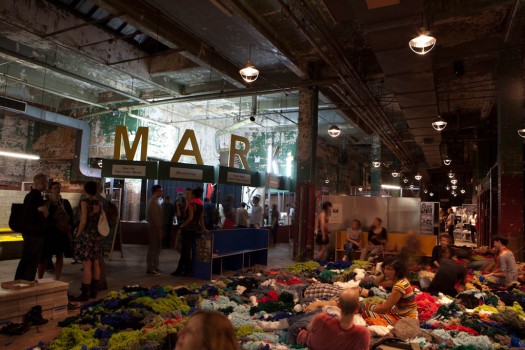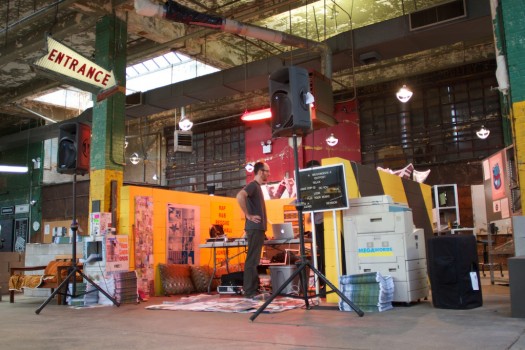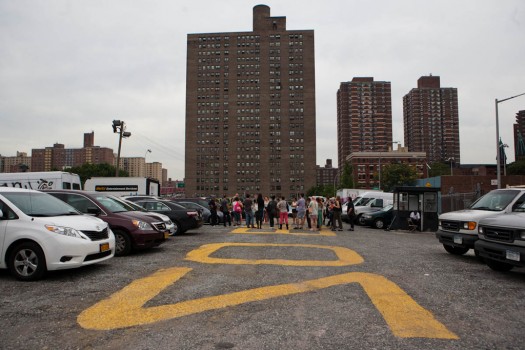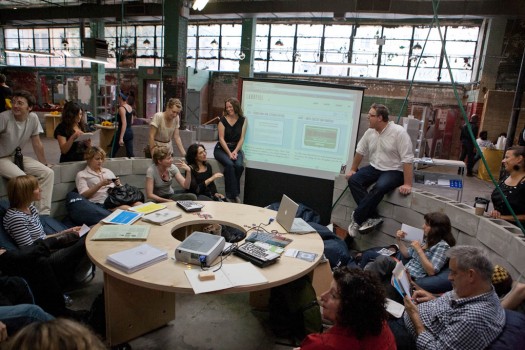
Celebrate ten years of Urban Omnibus and support ten more years of fresh, independent perspectives on citymaking with a donation today!
Celebrate ten years of Urban Omnibus and support ten more years of fresh, independent perspectives on citymaking with a donation today!

Living as Form | Essex Street Market | Photo by Sam Horine, courtesy of Creative Time
When Creative Time’s latest exhibition Living As Form opened at the historic Essex Street Market on September 24th, it wasn’t without context. Just four months earlier, the Festival of Ideas for the New City brought scores of people to the nearby Bowery to think about urban spaces, generating new notions full of imagination and creativity. Then, exactly a week prior to the exhibition’s opening, the occupation of Wall Street began in downtown Manhattan, demanding change that would halt the growing division of wealth in America. Somewhere between the more whimsical aspects of the Festival of Ideas and the very real outrage of the 99% stood Living As Form, an examination of socially engaged art, what Creative Time Chief Curator Nato Thompson has called a move “away from representation to participation.” With the growing momentum of the zeitgeist, he and 25 curators gathered 20 years’ worth of international civic works, new commissions and a motley schedule of events — more than 100 in total — that “blur the forms of art and everyday life.”
The collected works served as an archive — and were even displayed in industrial gray shelving — of some of the most effective projects in social art, from developing an alternative currency still in use today in Ithaca, New York (Ithaca HOURs) to physically reviving and re-purposing an inner-city neighborhood of Houston, Texas (Project Row Houses). Because each project carried with it a significant amount of background, trying to make a way through this archive was difficult, and, unfortunately, it seemed that the conspicuous projects garnered most of the attention, like Jeremy Deller’s “The Battle of Orgreave,” a video re-enactment of a violent clash between protesting miners and local police in rural England.

Installation by Megawords | Photo via megawordsmagazine.com
The newly commissioned works were some of the more accessible, including Surasi Kusolwong’s “Golden Ghost (The Future Belongs To),” a mass of industrial thread waste in which golden necklaces had been hidden and where children played and couples took pictures of each other, and the hangout spot created by Megawords, where one could put on a record and lounge against pillows on the floor. Bartering workshops and a barter advisor (by Our Goods) as well as Time/Bank — where people could advertise their “haves” and “needs” — served to give visitors direct interaction with and useful methods of challenging standard forms of living.
While no show about civic works could ignore cultural context, Living As Form succeeded in understanding its physical place. Not only was the layout of the space (designed by Common Room) highly approachable, constructed with cinder blocks, foam cubes and neon lights, but awareness of the neighborhood also played a central role. The exhibition hosted a series of walking tours that explored the streets of the Lower East Side and Chinatown, and guides (activists and artists alike) pointed out a building’s physical feature or a contested property and encouraged walkers to listen to the soundscape or understand the complexity of SPURA, the Seward Park Urban Renewal Area, large parking lots adjacent to the market that currently sit as the largest undeveloped tract of city-owned land south of 96th Street. SPURA, in fact, was a focal point of the exhibition, where commissioned artist Bik Van der Pol installed large text that read “As Above / So Below” to call attention to the stalemated evolution of the area.

Bik Van der Pol’s Elements of Composition | Photo by Sam Horine, courtesy of Creative Time
Like a mist, the Occupy Wall Street (OWS) movement permeated almost every aspect of Living As Form. People on walking tours talked about it between sites, those in the space casually made references to it, and an area for painting OWS protest signs was continually in use. For many, each piece in the archive felt like a guide for how to approach the changes being called for by the movement. Many involved with the show were compelled to action and a conversation at the Creative Time Summit (which ran in conjunction with the exhibition’s opening) called “Manifestations of Resistance” was scrapped by both the speakers and the audience, who marched instead to Wall Street to join in support. Many of these same people met the following day to discuss meaningful forms of involvement, out of which came the Occupied Wall Street Journal and the Occupennial, among other projects.
The palpable public archive in and events surrounding Living As Form (which was free to attend) was a refreshing change from some of the more insular (pay-to-attend), sometimes fanciful, idea-generating events of late. Here was a collaborative, thoughtful effort, executed in real terms and providing tools for action. Obviously, the conversation on social change as art is far from over, and Creative Time expects to publish a book with MIT Press (now on pre-order) in January 2012 with new essays and insights.

Living as Form | Ted Purves and Elyse Mallouk presenting Landfill (thelandfill.org) | Photo by Sam Horine, courtesy of Creative Time
The views expressed here are those of the author only and do not reflect the position of Urban Omnibus editorial staff or the Architectural League of New York.
The views expressed here are those of the authors only and do not reflect the position of The Architectural League of New York.
Comments